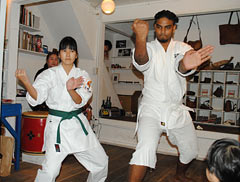Hiwat from Suriname practices karate in Okinawa

Sherus Hiwat (right) from Republic of Suriname demonstrating his karate skills to locals in Matsuo, Naha.
January 10, 2011 Ryukyu Shimpo
Sherus Hiwat from the Republic of Suriname in South America, who is traveling to learn five countries’ martial arts including Korean taekwondo, Muay Thai of Thailand and Chinese kung fu, came to Okinawa at the end of last September to study karate where it originated. Hiwatt said, “I understand that here in Okinawa karate is deeply ingrained in people’s lives. I will be able to experience the essence of karate by learning it here in Okinawa.” He is busy practicing under the tutelage of Kounanryu grand-master Fujiyoshi Kinjo at the Tsuboya Children’s Center in Naha.
Hiwat has been interested in martial arts since he was child, and he attended a boxing gym in Suriname when he was in his teens. He was dedicated to his practice, but there were no trainers capable of explaining the logic behind certain movements, or why they needed to do certain types of practice.
When he went to Mexico, which has a much longer history than Suriname in the sport of boxing, he asked a boxer about these things, and gained a better understanding of the meaning of footwork. “If I don’t learn a martial art closer to where it actually originated, I will never be able to master it in its pure form.” Then he decided to visit the places or origin of the martial arts that were of particular interest to him.
Studying karate in Okinawa for one year, he sets off on his ten-year plan to learn aiki jujutsu of Osaka, taekwondo, Muay Thai, kung fu and the traditional martial art from India called kalaripayattu.
After coming to Okinawa in September last year, Hiwat looked for a karate master in the southern part of the main island. At an event, he saw the karate performance of Yoneko Akamine, a resident of Tsuboya in Naha who has studied kounanryu and he talked to her about his plans. Since then he has practiced under the tutelage of Akamine’s mentor, Grand-Master Fujiyoshi Kinjo.
When he is not practicing, he helps to sell eggs at a store run by Akamine in Shintenchi-Ichiba Hondori in Makishi, Naha. He is called Keeba by the local children because he wears a necklace made of animal teeth, or kiba in Japanese.
“I’m living far away from my family and friends, so it is difficult at times, but I am determined to learn the essence of martial arts,” said Hiwat said.
(English translation by T&CT, Lima Tokumori and Mark Ealey)
Previous Article:FEC to distribute its Funny tales about U.S. military bases in Okinawa on an on-demand video service
Next Article:”Good luck” shisa cheer up Fukushima at an exhibition in Koriyama
[Similar Articles]
- “The Martial Art of Peace,” the essence of Okinawa Karate, performed by 5 top Karate figures for Karate Day celebration
- Committee formed in order to inscribe Okinawa Karate on the UNESCO Intangible Cultural Asset List
- Karate and traditional martial arts symposium held in Naha
- Six Dojos come together to perform Karate demonstration praying for the Shuri Castle reconstruction and to give courage to the region
- 130 Karate-ka from all over the world gather for Shima-ha Shorin-ryu training camp
 Webcam(Kokusai Street)
Webcam(Kokusai Street)


